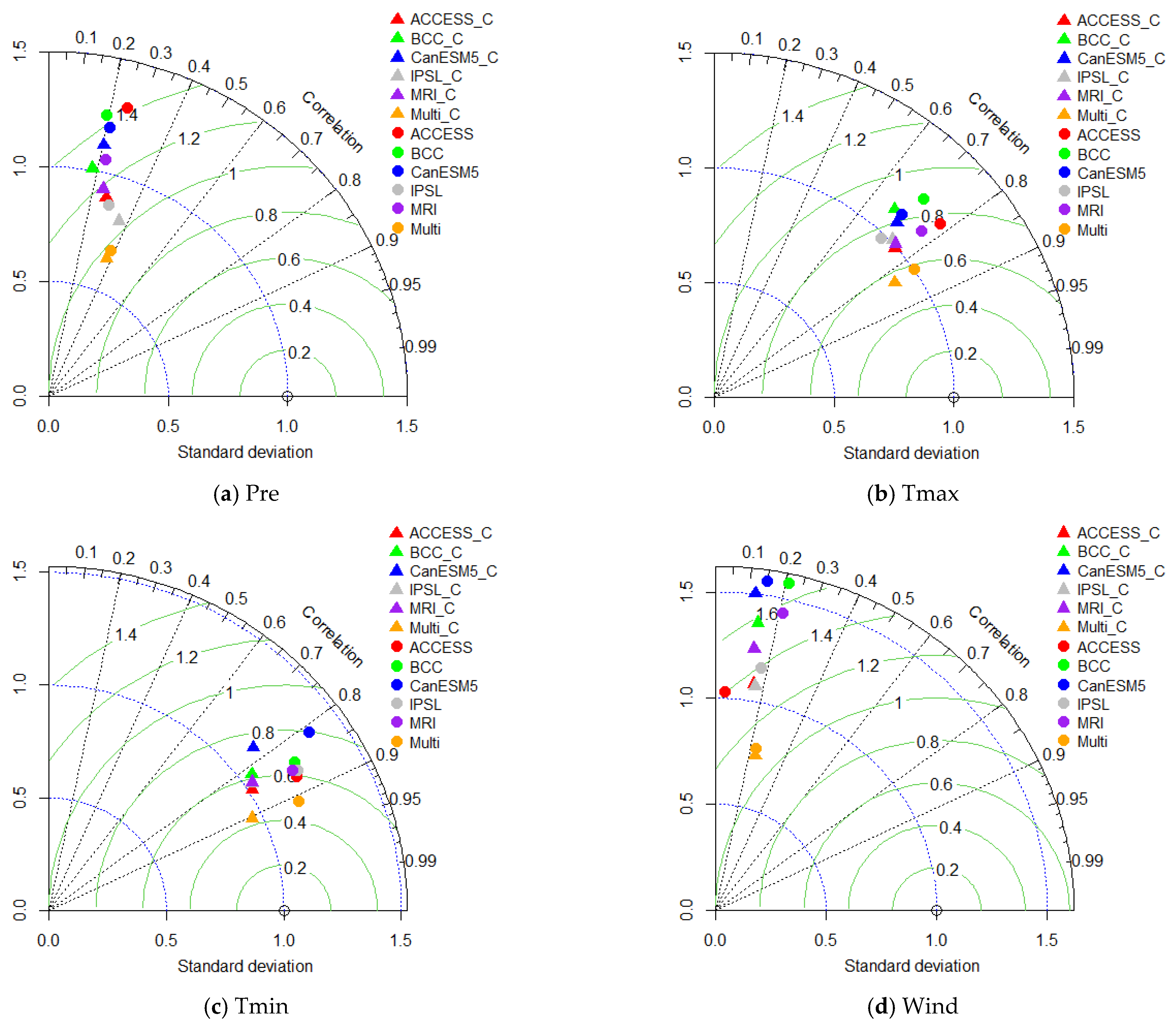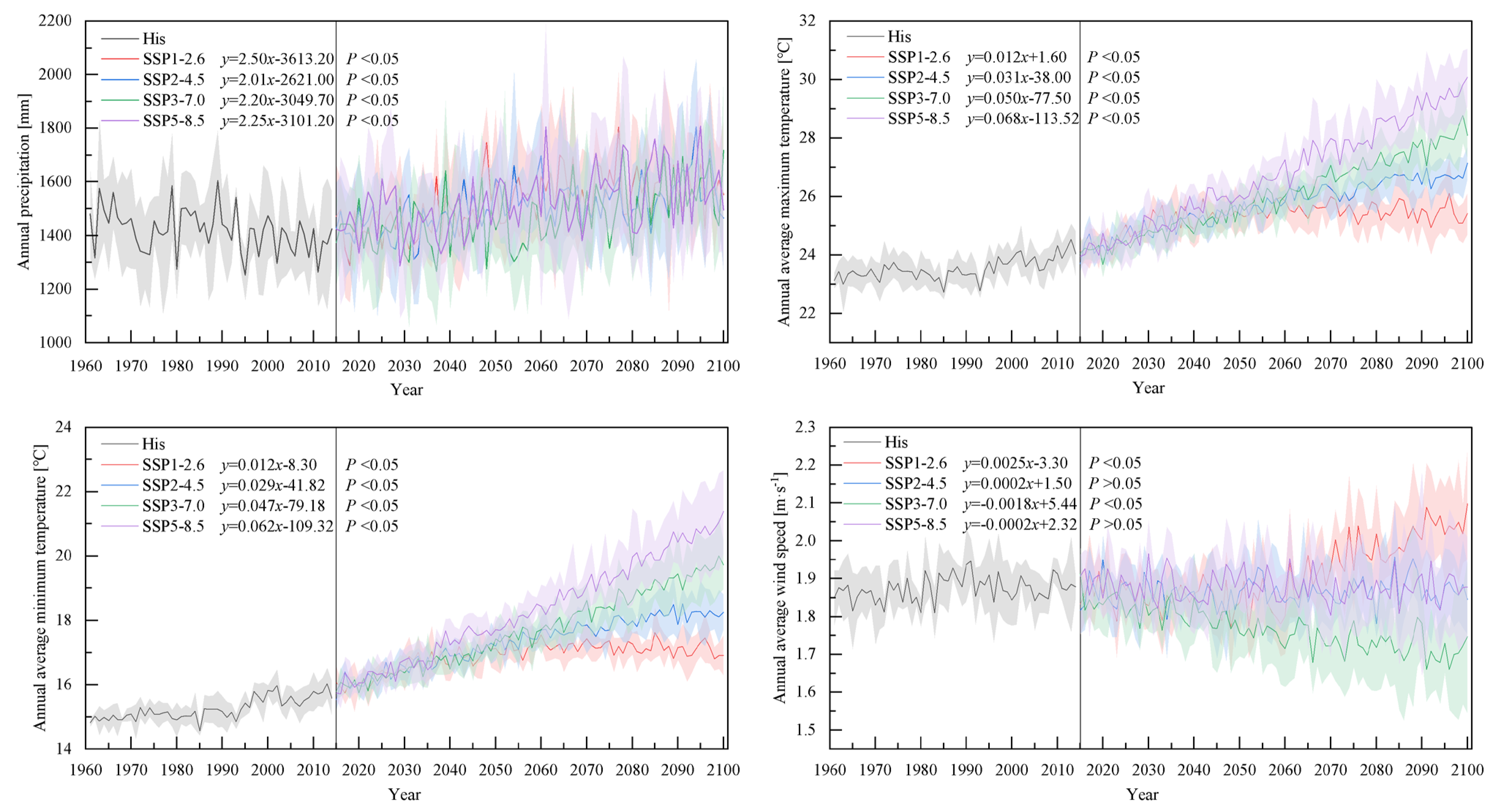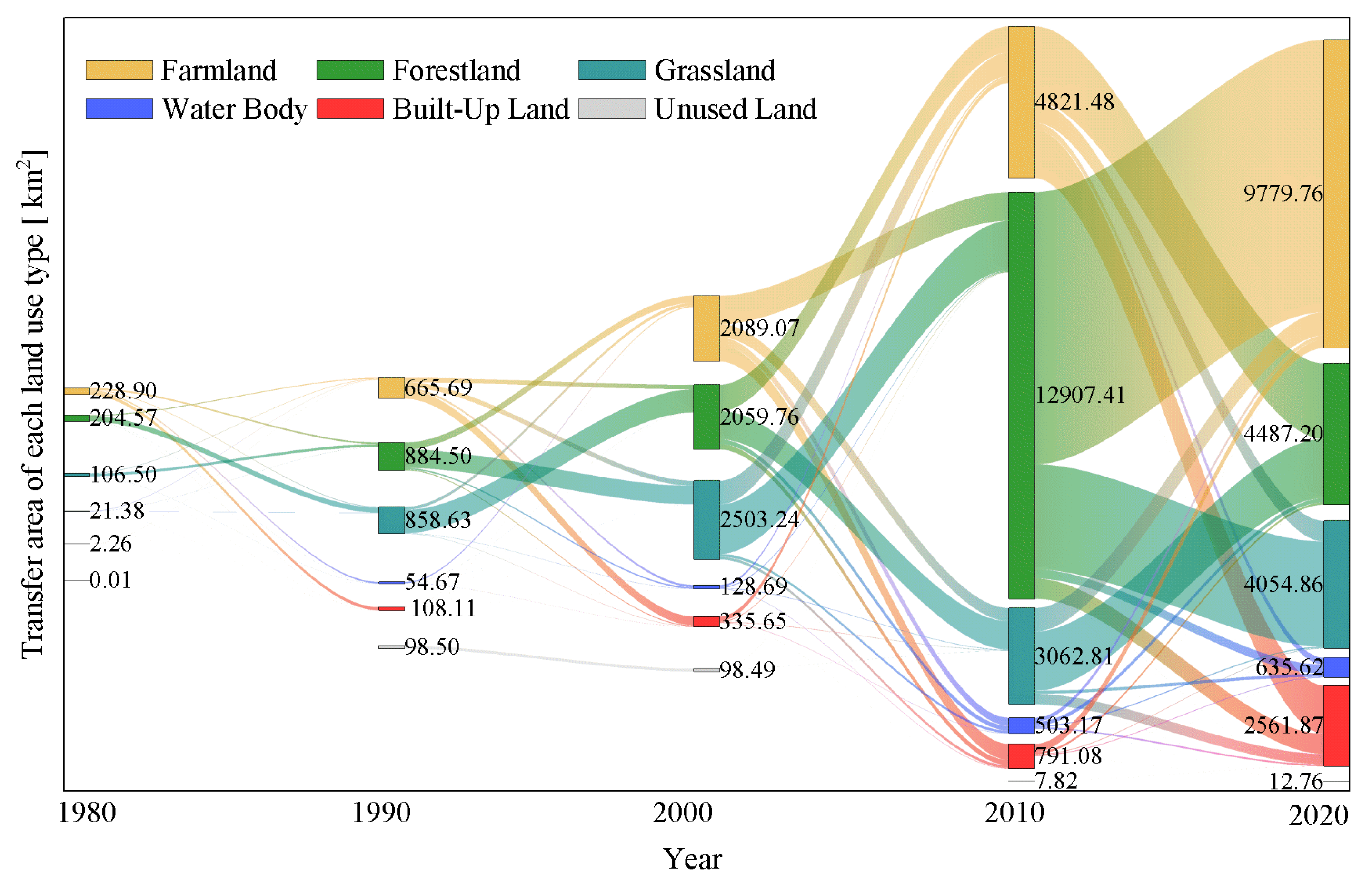Matching Degree between Agricultural Water and Land Resources in the Xijiang River Basin under Changing Environment
Abstract
:1. Introduction
2. Materials and Methods
2.1. Study Area
2.2. Model and Data
2.3. Method
2.3.1. Delta Statistical Downscaling
2.3.2. VIC-3L Model Calibration and Evaluation
2.3.3. Calculation of Matching Coefficient of Agricultural Water and Land Resources
3. Results
3.1. Climate Changing Trend
3.1.1. Climate Models Evaluation
3.1.2. Climate Change Characteristics
3.2. Water Resource Changing Trend
3.2.1. VIC-3L Model Calibration and Validation
3.2.2. Annual Total Runoff Changing Trend
3.3. Land Use Changing Trend
3.4. Matching Degree of Agricultural Water and Land Resources in the Xijiang River Basin
4. Discussion
5. Conclusions
Author Contributions
Funding
Data Availability Statement
Conflicts of Interest
References
- Yang, Y.; Zhang, W.; Feng, Z.; Liu, D. Land Use Change Induced Land and Water Resources Balance—A Case Study on the Xiliaohe Watershed. J. Nat. Resour. 2013, 28, 437–449. [Google Scholar]
- Cheng, K.; Fu, Q.; Chen, X.; Li, T.; Jiang, Q.; Ma, X.; Zhao, K. Adaptive Allocation Modeling for a Complex System of Regional Water and Land Resources Based on Information Entropy and Its Application. Water Resour. Manag. 2015, 29, 4977–4993. [Google Scholar] [CrossRef]
- Jiang, Q.; Fu, Q.; Wang, Z. Evaluation and Regional Differences of Water Resources Carrying Capacity in Sanjiang Plain. Trans. CSAE 2011, 27, 184–190. [Google Scholar]
- Uniyal, B.; Jha, M.K.; Verma, A.K. Assessing Climate Change Impact on Water Balance Components of a River Basin Using SWAT Model. Water Resour. Manag. 2015, 29, 4767–4785. [Google Scholar] [CrossRef]
- Shrestha, N.K.; Du, X.; Wang, J. Assessing Climate Change Impacts on Fresh Water Resources of the Athabasca River Basin, Canada. Sci. Total Environ. 2017, 601, 425–440. [Google Scholar] [CrossRef]
- Wang, S.; Ding, Y.; Ye, B.; Liao, J.; Xie, Z. A Land Use Analysis Based on the Influences of Climate Change and Human Activities—A Case Study in the Aksu River Basin Oasis. J. Glaciol. Geocryol. 2012, 34, 828–835. [Google Scholar]
- Jiang, C.; Xiong, L.; Wang, D.; Liu, P.; Guo, S.; Xu, C. Separating the Impacts of Climate Change and Human Activities on Runoff Using the Budyko-type Equations with Time-varying Parameters. J. Hydrol. 2015, 522, 326–338. [Google Scholar] [CrossRef]
- Gao, Y.; Qi, X.; Li, P.; Liang, Z.; Zhang, Y. Analysis on Spatial-temporal Matching Characteristics of Agricultural Water and Soil Resources in the Yellow River Basin. J. Irrig. Drain. 2021, 40, 113–118. [Google Scholar]
- Li, T.; Fu, Q.; Meng, F. Study on the Spatio-temporal Matching Patterns of Agricultural Water and Soil Resources in Heilongjiang Province. J. Northeast Agr. Univ. 2017, 48, 51–58. [Google Scholar]
- Xu, N.; Zhang, J.; Zhang, R.; Tian, F. Study on Matching Characteristics of Agricultural Water and Soil Resources Based on Dea-Take Gansu Province 5 Watersheds as an Example. China J. Agr. Resour. Reg. Plan. 2020, 41, 277–285. [Google Scholar]
- Zhang, Y.; Yan, Z.; Song, J.; Wei, A.; Sun, H.; Cheng, D. Analysis for Spatial-Temporal Matching Pattern Between Water and Land Resources in Central Asia. Hydrol. Res. 2020, 51, 994–1008. [Google Scholar] [CrossRef]
- Liu, D.; Liu, C.; Fu, Q.; Li, M.; Fu, Q.; Muhammad, A.; Muhammad, I.; Li, T.; Cui, S. Construction and application of a refined index for measuring the regional matching characteristics between water and land resources. Ecol. Indic. 2018, 91, 203–211. [Google Scholar] [CrossRef]
- Du, J.; Yang, Z.; Wang, H.; Yang, G.; Li, S. Spatial-Temporal Matching Characteristics between Agricultural Water and Land Resources in Ningxia, Northwest China. Water 2019, 11, 1460. [Google Scholar] [CrossRef] [Green Version]
- Geng, Q.; Liu, H.; He, X.; Tian, Z. Integrating Blue and Green Water to Identify Matching Characteristics of Agricultural Water and Land Resources in China. Water 2022, 14, 685. [Google Scholar] [CrossRef]
- Weng, Y.; Cai, W.; Wang, C. The Application and Future Directions of the Shared Socioeconomic Pathways (SSPs). Clim. Change Res. 2020, 16, 215–222. [Google Scholar]
- Sun, G.; Peng, F. Evaluation of Future Runoff Variations in the North–south Transect of Eastern China: Effects of Cmip5 Models Outputs Uncertainty. J. Water Clim. Change 2020, 11, 1355–1369. [Google Scholar] [CrossRef]
- Sun, J.; Yan, H.; Bao, Z.; Wang, G. Investigating Impacts of Climate Change on Runoff from the Qinhuai River by Using the SWAT Model and CMIP6 Scenarios. Water 2022, 14, 1778. [Google Scholar] [CrossRef]
- Zhao, J.; He, S.; Wang, H. Historical and Future Runoff Changes in the Yangtze River Basin from Cmip6 Models Constrained by a Weighting Strategy. Environ. Res. Lett. 2022, 17, 024015. [Google Scholar] [CrossRef]
- Hishe, S.; Bewket, W.; Nyssen, J.; Lyimo, J. Analysing Past Land Use Land Cover Change and Ca-markov-based Future Modelling in the Middle Suluh Valley, Northern Ethiopia. Geocarto Int. 2020, 35, 225–255. [Google Scholar] [CrossRef]
- Von Thaden, J.J.; Laborde, J.; Guevara, S.; Venegas-Barrera, C.S. Forest Cover Change in the Los Tuxtlas Biosphere Reserve and Its Future: The Contribution of the 1998 Protected Natural Area Decree. Land Use Policy 2018, 72, 443–450. [Google Scholar] [CrossRef]
- Tang, J.; Di, L. Past and Future Trajectories of Farmland Loss Due to Rapid Urbanization Using Landsat Imagery and the Markov-CA Model: A Case Study of Delhi, India. Remote Sens. 2019, 11, 180. [Google Scholar] [CrossRef] [Green Version]
- Vázquez-Quintero, G.; Solís-Moreno, R.; Pompa-García, M.; Villarreal-Guerrero, F.; Pinedo-Alvarez, C.; Pinedo-Alvarez, A. Detection and Projection of Forest Changes by Using the Markov Chain Model and Cellular Automata. Sustainability 2016, 8, 236. [Google Scholar] [CrossRef] [Green Version]
- Huang, Y.; Yang, B.; Wang, M.; Liu, B.; Yang, X. Analysis of the Future Land Cover Change in Beijing Using Ca-markov Chain Model. Geocarto Int. 2020, 79, 60. [Google Scholar] [CrossRef]
- Chen, L.; Liu, B. Hydro-meteorological Integrated Drought Evaluation of Xijiang River Basin. Water Resour. Power 2022, 40, 17–21. [Google Scholar]
- Zhang, Y.; Wu, T.; Song, C.; Hein, L.; Shi, F.; Han, M.; Ouyang, Z.Y. Influences of Climate Change and Land Use Change on the Interactions of Ecosystem Services in China’s Xijiang River Basin. Ecosyst. Ser. 2022, 58, 101489. [Google Scholar] [CrossRef]
- Touseef, M.; Chen, L.; Masud, T.; Khan, A.; Yang, K.; Shahzad, A.; Wajid Ijaz, M.; Wang, Y. Assessment of the Future Climate Change Projections on Streamflow Hydrology and Water Availability over Upper Xijiang River Basin, China. Appl. Sci. 2020, 10, 3671. [Google Scholar] [CrossRef]
- Liu, S.; Wang, J.; Wei, J.; Wang, H. Hydrological Simulation Evaluation with WRF-Hydro in a Large and Highly Complicated Watershed: The Xijiang River Basin. J. Hydrol. Reg. Stud. 2021, 38, 100943. [Google Scholar] [CrossRef]
- Lin, Q.; Wu, Z.; Liu, J.; Singh, V.P.; Zuo, Z. Hydrological Drought Dynamics and Its Teleconnections with Large-scale Climate Indices in the Xijiang River Basin, South China. Theor. Appl. Climatol. 2022, 150, 229–249. [Google Scholar] [CrossRef]
- Zhou, T.; Zou, L.; Chen, X. Commentary on the Coupled Model Intercomparison Project Phase 6 (CMIP6). Clim. Change Res. 2019, 15, 445–456. [Google Scholar]
- Zhang, L.; Chen, X.; Xin, X. Short Commentary on CMIP6 Scenario Model Intercomparison Project (ScenarioMIP). Clim. Change Res. 2019, 15, 519–525. [Google Scholar]
- Zhao, M.; Su, B.; Jiang, T.; Wang, A.; Tao, H. Simulation and Projection of Precipitation in the Upper Yellow River Basin by CMIP6 Multi-Model Ensemble. Plateau Meteorol. 2021, 40, 547–558. [Google Scholar]
- Hay, L.E.; Wilby, R.L.; Leavesley, G.H. A Comparison of Delta Change and Downscaled GCM Scenarios for Three Mountainous Basins in the United States. J. Am. Water Resour. Assoc. 2010, 36, 387–397. [Google Scholar] [CrossRef]
- Jian, S.; Wang, A.; Su, C.; Wang, K. Prediction of Future Spatial and Temporal Evolution Trends of Reference Evapotranspiration in the Yellow River Basin, China. Remote Sens. 2022, 14, 5674. [Google Scholar] [CrossRef]
- Hao, Z.; Li, L.; Xu, Y.; Ju, Q.; Yan, J.; Luo, J.; Wang, J.; Hao, J. Study on Delta-DCSID Downscaling Methond of GCM Outpu. J. Sichuan Univ. Eng. Sci 2009, 41, 1–7. [Google Scholar]
- Ray, R.L.; Jacobs, J.M.; Cosh, M.H. Landslide Susceptibility Mapping Using Downscaled Amsr-e Soil Moisture: A Case Study from Cleveland Corral, California, US. Remote Sens. Environ. 2010, 114, 2624–2636. [Google Scholar] [CrossRef]
- Jiang, S.; Ren, L.; Yong, B.; Fu, C.; Yang, X. Analyzing the Effects of Climate Variability and Human Activities on Runoff from the Laohahe Basin in Northern China. Hydrol. Res. 2012, 43, 3–13. [Google Scholar] [CrossRef]
- Dash, S.S.; Sahoo, B.; Raghuwanshi, N.S. How Reliable Are the Evapotranspiration Estimates by Soil and Water Assessment Tool (SWAT) and Variable Infiltration Capacity (VIC) Models for Catchment-scale Drought Assessment and Irrigation Planning? J. Hydrol. 2020, 592, 125838. [Google Scholar] [CrossRef]
- Liu, Y.; Gan, H.; Zhang, F. Analysis of the Matching Patterns of Land and Water Resources in Northeast China. Acta Geogr. Sin. 2006, 61, 847–854. [Google Scholar]
- Zhao, D.; Chen, X.; Han, Y.; Zhao, Y.; Men, X. Study on the Matching Method of Agricultural Water and Land Resources from the Perspective of Total Water Footprint. Water 2022, 14, 1120. [Google Scholar] [CrossRef]
- Wang, J.; Xin, L.; Dai, E. Spatio-temporal Variations of the Matching Patterns of Agricultural Land and Water Resources in Typical Mountainous Areas of China. Geogr. Res. 2020, 39, 1880–1890. [Google Scholar]
- Themessl, M.J.; Gobiet, A.; Leuprecht, A. Empirical-statistical Downscaling and Error Correction of Daily Precipitation from Regional Climate Models. Int. J. Climatol. 2011, 31, 1530–1544. [Google Scholar] [CrossRef]
- Zhang, Q.; Shen, Z.; Xu, C.; Sun, P.; Hu, P.; He, C. A New Statistical Downscaling Approach for Global Evaluation of the CMIP5 Precipitation Outputs: Model Development and Application. Sci. Total Environ. 2019, 690, 1048–1067. [Google Scholar] [CrossRef] [PubMed]
- Khan, M.S.; Coulibaly, P.; Dibike, Y. Uncertainty Analysis of Statistical Downscaling Methods. J. Hydrol. 2006, 319, 357–382. [Google Scholar] [CrossRef]
- Arfa, S.; Nasseri, M.; Tavakol-Davani, H. Comparing the Effects of Different Daily and Sub-Daily Downscaling Approaches on the Response of Urban Stormwater Collection Systems. Water Resour. Manag. 2021, 35, 505–533. [Google Scholar] [CrossRef]
- Karger, D.N.; Schmatz, D.R.; Dettling, G.; Zimmermann, N.E. High-resolution Monthly Precipitation and Temperature Time Series from 2006 to 2100. Sci. Data 2022, 9, 262. [Google Scholar] [CrossRef]
- Wang, S.; Jiao, X.; Wang, L.; Sang, H.; Salahou, M.K.; Maimaitiyiming, A. Assessing Climate Change Impacts on Water Resources of the Hotan Oasis Using SWAT Model, Northwest China. Fresen. Environ. Bull. 2019, 28, 1801–1810. [Google Scholar]
- Wang, X.; Liu, H.; Bao, A. A Simulation Analysis of the Impact of Climate Change on Runoff in the Manas River. J. Glaciol. Geocryol. 2012, 34, 1221–1228. [Google Scholar]
- Cao, C.; Sun, R.; Wu, Z.; Li, J. Responses of Streamflow to Climate Change in Upstream of Nandujiang River Basin on SWAT Model. Res. Soil Water Conserv. 2022, 29, 255–264. [Google Scholar]
- Jia, H.; Li, X.; Wen, J.; Chen, Y. Runoff Change Simulation and Future Trend Projection in the Source Area of the Yellow River. Resour. Sci. 2022, 44, 1292–1304. [Google Scholar] [CrossRef]
- Zhu, D. Quantitative Assessment of Impact of Land Use/Cover Change on Runoff Process in Xijiang River Basin Based on GEE. Water Resour. Power 2022, 40, 36–43. [Google Scholar]
- Durmusoglu, Z.O.; Tanriover, A.A. Modelling Land Use/Cover Change in Lake Mogan and Surroundings Using CA-Markov Chain Analysis. J. Environ. Biol. 2017, 38, 981–989. [Google Scholar] [CrossRef]
- Wang, S.; Jiao, X.; Wang, L.; Gong, A.; Sang, H.; Salahou, M.K.; Zhang, L. Integration of Boosted Regression Trees and Cellular Automata—Markov Model to Predict the Land Use Spatial Pattern in Hotan Oasis. Sustainability 2020, 12, 1396. [Google Scholar] [CrossRef] [Green Version]
- Zhou, R. Study on the Drought and Flood Disasters Formation Mechanism in Karst Area of Southwest China. Master’s Thesis, Guilin University of Technology, Guilin, China, 2014. [Google Scholar]
- Wu, Z.; Lin, Q. Analysis on spatial and temporal characteristics of hydrological drought in Xijiang River Basin. Water Resour. Prot. 2016, 32, 51–56. [Google Scholar]
- Li, X.; Hao, J.; Chen, A. Time-space Matching Pattern and Evaluation of Agricultural Water and Soil Resources in Shandong Province. J. China Agr. Univ. 2020, 25, 1–11. [Google Scholar]
- Wang, L.; Cui, W.; Liu, S.; Mu, H.; Lu, X. Spatial Temporal Matching Pattern of Agricultural Water and Land Resources in Guizhou Province. Water Resour. Power 2021, 39, 33–36. [Google Scholar]







| Index | Model | Spatial Resolution | Research Institution, Country |
|---|---|---|---|
| 1 | BCC-CSM2-MR | 1.125° × 1.125° | BBC, China |
| 2 | CanESM5 | 2.8° × 2.8° | CCCMA, Canada |
| 3 | ACCESS-CM2 | 1.25° × 1.875° | CSIRO-ARCCSS, Australia |
| 4 | MRI-ESM2-0 | 1.125° × 1.125° | MRI, Japan |
| 5 | IPSL-CM6A-LR | 1.27° × 2.5° | IPSL, France |
| Parameter | Description | Unit | Value Range | Fitting Value |
|---|---|---|---|---|
| Binf | Variable infiltration curve parameter | 1 | [0, 1] | 0.35 |
| DS | Dsmax fraction where nonlinear baseflow originates | 1 | [0, 1] | 0.17 |
| Dsmax | Maximum velocity of baseflow | mm/d | [0, 40] | 18 |
| Ws | Fraction of maximum soil moisture where nonlinear baseflow occurs | 1 | [0, 1] | 0.9 |
| D1 | Thickness of top (first) soil layer | m | - | 0.1 |
| D2 | Thickness of second soil layer | m | [0, 1] | 0.4 |
| D3 | Thickness of third soil layer | m | [1, 2] | 0.7 |
| Period | Index | Gaoyao |
|---|---|---|
| Calibration (2007–2010) | NSE | 0.80 |
| RSR | 0.46 | |
| PBIAS | 6.79% | |
| Validation (2011–2013) | NSE | 0.76 |
| RSR | 0.53 | |
| PBIAS | 7.88% |
| Land Classification | 1980 | 1990 | 2000 | 2010 | 2020 | Change of 1980 to 2020 |
|---|---|---|---|---|---|---|
| Farmland | 74,360 | 74,193 | 73,892 | 73,605 | 78,561 | 4201 |
| Forestland | 210,470 | 210,404 | 210,401 | 210,880 | 202,444 | −8025 |
| Grassland | 48,619 | 48,709 | 48,602 | 47,459 | 48,446 | −173 |
| Water Body | 3813 | 3846 | 3925 | 4300 | 4582 | 769 |
| Built-Up Land | 4229 | 4335 | 4669 | 5256 | 7437 | 3208 |
| Unused Land | 99 | 98 | 98 | 92 | 97 | −2 |
Disclaimer/Publisher’s Note: The statements, opinions and data contained in all publications are solely those of the individual author(s) and contributor(s) and not of MDPI and/or the editor(s). MDPI and/or the editor(s) disclaim responsibility for any injury to people or property resulting from any ideas, methods, instructions or products referred to in the content. |
© 2023 by the authors. Licensee MDPI, Basel, Switzerland. This article is an open access article distributed under the terms and conditions of the Creative Commons Attribution (CC BY) license (https://creativecommons.org/licenses/by/4.0/).
Share and Cite
Wang, S.; Wang, L. Matching Degree between Agricultural Water and Land Resources in the Xijiang River Basin under Changing Environment. Water 2023, 15, 827. https://doi.org/10.3390/w15040827
Wang S, Wang L. Matching Degree between Agricultural Water and Land Resources in the Xijiang River Basin under Changing Environment. Water. 2023; 15(4):827. https://doi.org/10.3390/w15040827
Chicago/Turabian StyleWang, Shufang, and Liping Wang. 2023. "Matching Degree between Agricultural Water and Land Resources in the Xijiang River Basin under Changing Environment" Water 15, no. 4: 827. https://doi.org/10.3390/w15040827
APA StyleWang, S., & Wang, L. (2023). Matching Degree between Agricultural Water and Land Resources in the Xijiang River Basin under Changing Environment. Water, 15(4), 827. https://doi.org/10.3390/w15040827





